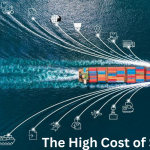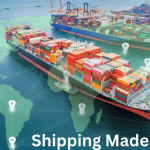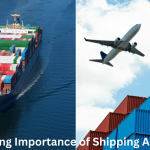Automation is rapidly transforming the US shipping industry, from port operations to last-mile delivery. As technology advances, automation has become essential for improving efficiency, reducing costs, and meeting the increasing demand for faster, more reliable shipping services. While the introduction of automation brings numerous benefits, it also raises concerns regarding labor displacement, the need for new skills, and broader economic implications.
This article explores the impact of automation on the US shipping industry, examining its benefits, challenges, and the future of shipping in an automated world.
The Rise of Automation in Shipping
Automation in shipping involves the use of technology to carry out tasks traditionally performed by humans, often with greater speed and accuracy. Automation encompasses a range of technologies, including artificial intelligence (AI), robotics, autonomous vehicles, machine learning, and the Internet of Things (IoT). These technologies are being applied in various stages of the shipping process, from warehouse operations and port management to transportation and delivery.
In the US, automation in shipping is driven by several key factors:
- Increased E-commerce Demand: The rapid growth of e-commerce has led to a surge in shipping volumes, pushing logistics companies to automate their operations to meet customer expectations for fast and reliable delivery.
- Labor Shortages: The shipping industry faces labor shortages, particularly in warehousing, trucking, and delivery services. Automation provides a solution to these shortages by supplementing human labor with machines and technology.
- Cost Efficiency: Automation reduces operational costs by increasing efficiency and reducing the need for manual labor, making it an attractive option for businesses looking to remain competitive.
- Technological Advancements: The availability of advanced technologies, such as AI and robotics, has made automation more feasible and cost-effective for shipping companies.
Key Areas of Automation in US Shipping
Automation is being implemented across various aspects of the US shipping industry, revolutionizing the way goods are transported, handled, and delivered. Below are some key areas where automation is making a significant impact:
1. Port Operations
US ports are a critical part of the shipping infrastructure, facilitating the movement of goods between countries. Automation is increasingly being used to streamline port operations, enhancing efficiency and reducing bottlenecks. Some of the key automated technologies used in ports include:
- Automated Cranes: These cranes use AI and robotics to load and unload cargo containers from ships with minimal human intervention. Automated cranes can work around the clock, reducing unloading times and improving the flow of goods.
- Autonomous Guided Vehicles (AGVs): AGVs transport containers between the port and storage areas without human drivers, reducing labor costs and increasing operational efficiency.
- Automated Warehouses: Ports are also implementing automated storage and retrieval systems (AS/RS) to streamline inventory management and improve warehouse efficiency.
2. Warehouse Automation
Warehouses play a vital role in the shipping process, acting as hubs for the storage, sorting, and distribution of goods. Automation is transforming warehouses across the US, with companies adopting advanced technologies to improve efficiency and reduce reliance on manual labor. Examples of warehouse automation include:
- Robotic Sorting Systems: These systems use AI-driven robots to sort and organize packages, speeding up the process and reducing errors.
- Automated Picking Systems: Robots are increasingly being used for picking and packing items, reducing the time it takes to fulfill orders.
- Drones and Automated Guided Vehicles (AGVs): Drones and AGVs are being used within warehouses to transport goods from one area to another, further reducing the need for human intervention.
3. Transportation and Autonomous Vehicles
Transportation is a critical component of shipping, and automation is set to revolutionize this area through the use of autonomous vehicles. While fully autonomous trucks have not yet become mainstream, the technology is advancing rapidly, and several companies are already testing driverless trucks on US highways.
- Autonomous Trucks: These self-driving vehicles use sensors, cameras, and AI to navigate roads without human drivers. Autonomous trucks can operate for longer periods without rest, reducing transportation times and costs. Companies like Waymo and Tesla are developing autonomous trucks with the potential to transform long-haul shipping.
- Platooning: Platooning involves multiple trucks traveling in a convoy, with the lead truck controlled by a human driver and the rest following autonomously. This reduces fuel consumption, lowers emissions, and improves road safety.
4. Last-Mile Delivery Automation
The final step in the shipping process—getting goods from a distribution center to the customer’s door—is known as last-mile delivery. This stage is often the most expensive and time-consuming part of the logistics process, and automation is playing an increasingly important role in improving last-mile efficiency.
- Delivery Drones: Drones are being used for small, short-distance deliveries, particularly in urban areas. Companies like Amazon and UPS are testing drone delivery systems that can drop off packages directly to customers’ homes, reducing delivery times and costs.
- Autonomous Delivery Robots: Small, autonomous robots are being used to deliver goods in densely populated areas. These robots can navigate sidewalks and deliver packages to customers without the need for a human courier.
Benefits of Automation in Shipping
Automation offers several significant benefits to the US shipping industry, including:
1. Increased Efficiency
Automation can perform repetitive tasks faster and more accurately than humans, improving overall efficiency. For example, robotic sorting systems in warehouses can process thousands of packages per hour, far surpassing the capabilities of manual labor. Similarly, autonomous trucks can operate around the clock, reducing delivery times and increasing shipping capacity.
2. Cost Savings
By reducing the need for human labor, automation can lower operational costs for shipping companies. Automated systems can also reduce fuel consumption, energy usage, and maintenance costs, contributing to long-term savings.
3. Improved Accuracy
Automation minimizes human errors in shipping processes, from sorting packages to navigating transportation routes. This improves the accuracy of deliveries, reducing the likelihood of lost or damaged goods.
4. Enhanced Safety
Automation can improve safety in the shipping industry by reducing the need for human workers in hazardous environments. For example, autonomous vehicles can navigate dangerous roads, while robots can handle heavy or hazardous materials in warehouses, reducing the risk of accidents.
5. Scalability
As demand for shipping services increases, automation allows companies to scale their operations more easily. Automated systems can handle larger volumes of goods without the need for additional labor, making it easier for companies to expand their logistics networks.
Challenges and Concerns of Automation
While automation offers numerous benefits, it also presents several challenges and concerns that need to be addressed:
1. Labor Displacement
One of the most significant concerns about automation is its potential to displace human workers. As machines take over tasks traditionally performed by humans, there is a risk of job losses, particularly in roles such as warehouse workers, truck drivers, and delivery couriers. However, new jobs may emerge in areas such as technology maintenance, data analysis, and robotics.
2. High Initial Costs
Implementing automation technologies requires significant upfront investment, particularly for small and medium-sized businesses. The cost of purchasing and maintaining robots, autonomous vehicles, and other automated systems can be a barrier to entry for some companies.
3. Regulatory and Legal Challenges
The widespread adoption of autonomous vehicles and drones in shipping raises regulatory and legal challenges, particularly concerning safety, liability, and privacy. Governments will need to develop new regulations to ensure the safe integration of these technologies into the shipping infrastructure.
4. Technological Limitations
While automation technology is advancing rapidly, there are still limitations to what machines can achieve. Autonomous vehicles, for example, may struggle in complex traffic situations or adverse weather conditions, limiting their widespread adoption.
The Future of Automation in US Shipping
The future of US shipping is undoubtedly shaped by automation, with continued advancements in AI, robotics, and autonomous vehicles set to revolutionize the industry. As automation technologies become more accessible and cost-effective, they will play an increasingly important role in improving the efficiency, safety, and sustainability of shipping operations.
However, the successful integration of automation into the shipping industry will require addressing challenges such as labor displacement, regulatory hurdles, and technological limitations. By embracing automation while considering its broader social and economic implications, the US shipping industry can navigate the future of logistics in a rapidly evolving world.
In conclusion, automation is transforming the US shipping industry by increasing efficiency, reducing costs, and improving safety. While challenges remain, the potential benefits of automation make it a vital tool for the future of shipping in the US and beyond.
FAQs
1. What is automation in shipping?
Automation in shipping refers to the use of technology, such as robotics, artificial intelligence (AI), and autonomous vehicles, to perform tasks that were previously done manually. Automation streamlines processes in warehouses, ports, and transportation, improving efficiency, reducing costs, and enhancing the overall supply chain.
2. How does automation affect port operations?
Automation enhances port operations by using automated cranes and AGVs to load and unload containers. These technologies improve efficiency and reduce wait times for ships, which leads to faster processing of goods through ports and reduced congestion.
3. What is warehouse automation?
Warehouse automation involves the use of robotics, AI, and other technologies to streamline tasks such as sorting, picking, packing, and transporting goods within a warehouse. This helps companies fulfill orders more quickly and efficiently, improving the supply chain.
4. What are autonomous trucks, and how do they impact shipping?
Autonomous trucks are self-driving vehicles that use sensors, cameras, and AI to navigate roads without human intervention. These trucks have the potential to reduce the need for human drivers, lower fuel consumption, and improve long-haul transportation efficiency in the shipping industry.
5. Will automation eliminate jobs in shipping?
Automation may displace some jobs, particularly those involving repetitive, manual tasks. However, it can also create new opportunities in technology-related roles, such as maintaining automated systems, software development, and data analysis. The challenge is ensuring that workers are retrained for these emerging roles.




